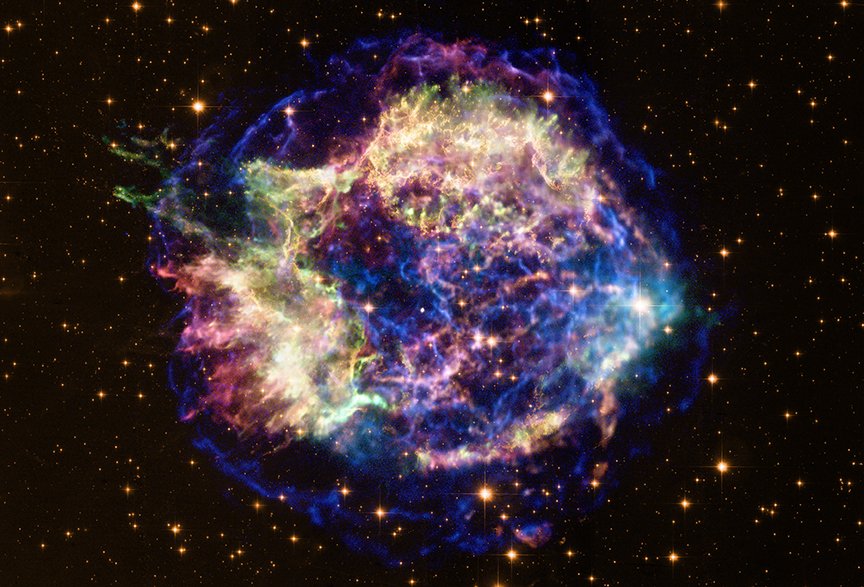 Earth & Space
Earth & Space
The Star That Wouldn’t Die
A star that seems to have exploded multiple times is defying all theories about stellar deaths.

Stars might seem eternal, but, like people, they are born, evolve and eventually die. A star will spend most of its life converting hydrogen into helium, a nuclear fusion process that produces energy which the star uses to hold itself up against its own gravity and to produce the light and heat that make it shine. Eventually, hydrogen will run out, fusion will fizzle, and the star will start to collapse under its own weight. As the star collapses, its core gets hotter and denser, until at some point the conditions for fusing helium into carbon and oxygen ignite that process, halting the collapse. Stars about 10 times more massive than our sun and larger, will go on to successive episodes of collapse and fusion of heavier elements, until they reach iron. Fusing iron into heavier elements no longer produces any energy, so at that stage the star is done for. It will collapse until the core is so dense that it forms a neutron star. The rest of the star bounces off the dense core and explodes in what is called a supernova. With tens of solar masses of material flying off at thousands of km/s, supernovae are some of the most energetic events in the Universe. For a period of a few months they can be as bright as billions of suns, outshining the entire galaxy in which they reside.
Though supernovae are relatively rare (about one star will explode as a supernova every 100 years per galaxy), modern telescopes using wide field digital cameras can image hundreds of thousands of galaxies per night, finding about one new supernova every hour. Thousands of such explosions have been studied in detail and several different types of supernovae have been identified. The most common type is the explosion of so-called red-supergiant stars - 10-20 solar-mass stars, made mostly of leftover hydrogen from their outer layers. These stars explode in what are called Type II-P supernovae which remain bright for about three months and then fade away for ever.
In September of 2014, the 48-inch telescope at the Palomar observatory in California was searching for supernovae as part of a several year-long project called the intermediate Palomar Transient Factory (iPTF). One of the supernovae it discovered, dubbed iPTF14hls, initially seemed uninteresting as it was already fading, having passed its peak luminosity earlier in the year while the telescope was not looking. However, the telescope kept monitoring iPTF14hls, and several months later we noticed it start to get bright again. This kind of behavior is very unusual for a supernova, so we took a spectrum of it's light - splitting it into a rainbow to check the composition, temperature and velocities of the exploding material. To our surprise, the spectrum looked like that of a typical Type II-P supernova, at about one month after explosion. But iPTF14hls was already several months into its explosion, and it was getting brighter instead of fainter.
iPTF14hls went on to fade and re-brighten at least four more times over the course of two years, all the while presenting the spectrum of a Type II-P evolving in slow motion (600 days after it was discovered, the spectrum looked exactly like that of a 60-day old Type II-P supernova). When we looked back in the archives we found that the same Palomar telescope had imaged the galaxy which hosted iPTF14hls already in 1954. To our surprise there appeared to be a supernova at the same position as iPTF14hls in that image - 60 years ago.
A supernova that fades and brightens five times, has the spectrum of a normal supernova 10 times younger, and had exploded at least once 60 years before - all of this is unprecedented and extremely puzzling. None of these properties can be coherently explained by any existing supernova theory.
Three years after its discovery, iPTF14hls continues to shine, though it is now finally fading for what appears to be the last time. This single star, which seems to have somehow exploded multiple times, is forcing us to re-think our theories about massive stars, their violent evolution and their explosive deaths.
Original Article:
I. Arcavi et al., Energetic eruptions leading to a peculiar hydrogen-rich explosion of a massive star. Nature 551, 210-213 (2017)Edited by:
Massimo Caine , Founder and Director
We thought you might like
How early-life adversity gets under the skin
May 19, 2016 in Health & Physiology | 3.5 min read by Joanne RyanAn exoplanet surrounded by an atmosphere larger than its star
Nov 26, 2015 in Earth & Space | 4 min read by Vincent BourrierTiny barcodes for a global food chain
Jun 7, 2021 in Health & Physiology | 4 min read by Christopher P. Mancuso , Jason QianMore from Earth & Space
Volcanic Ash: A Nutrient Boost for Reef-Building Corals
Sep 18, 2024 in Earth & Space | 4 min read by Frank Förster , Tom SheldrakeAmmonia Energy: A Call for Environmental Awareness
Aug 29, 2024 in Earth & Space | 3.5 min read by Matteo Bertagni , Robert Socolow , Amilcare PorporatoLikely increase in coral thermal tolerance at a Pacific archipelago
Dec 29, 2023 in Earth & Space | 3 min read by Liam LachsEarth’s large lakes are shrinking
Dec 27, 2023 in Earth & Space | 3 min read by Fangfang Yao , Ben Livneh , Balaji RajagopalanGas in distant galaxies: mixed or matched?
Nov 22, 2023 in Earth & Space | 3 min read by Tanita Ramburuth-HurtEditor's picks
Trending now
Popular topics


